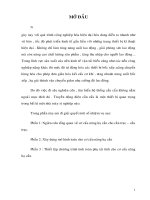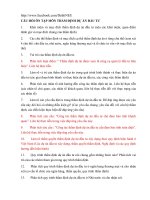Câu hỏi GIS, viễn thám, mô hình toán
Bạn đang xem bản rút gọn của tài liệu. Xem và tải ngay bản đầy đủ của tài liệu tại đây (1.95 MB, 8 trang )
<span class='text_page_counter'>(1)</span><div class='page_container' data-page=1>
Modeling Atmospheric Carbon Dioxide over the United States
Author Advisor
W. E. Long J. Ernstberger
LaGrange College
<b>Abstract</b>
In this undergraduate research project, we implement a published, component-based model of the
total carbon dioxide concentration in the atmosphere above the United States. To do so we use a simple
ordinary differential equation to quantify the behavior of the carbon cycle (as described in published
NOAA findings), compute curves of best fit to approximate CO<sub>2</sub> contributions due to emissions from
fossil fuels and forest fires, and employ Henry’s law to estimate the overall oceanic CO2absorption effect.
Finally, via residual comparison, model parameters are estimated to determine a model approximation.
<b>Introduction</b>
Carbon dioxide is a commonly discussed greenhouse gas. In the following sections, we seek to understand the
sources of carbon dioxide in the atmosphere. We examine a compartmental model of the total atmospheric
carbon dioxide concentration in comparison to collected atmospheric CO<sub>2</sub>data. We explore each individual
component of the model in the following sections. We have located previously recorded and published data for
each component, and we have determined a numerical solution and model each component separately and in
the aggregate using a variety of techniques, including differential equations and least squares approximations.
In each of the following sections, we present our methodology for modeling the component as well as benefits
and weaknesses in each particular method. We then present a final composite model representing the total
of the four components discussed, which indicates an increasing atmospheric concentration.
<b>Compartmental Model</b>
To model the concentration of carbon dioxide in the atmosphere, we will use a compartmental model discussed
in the Peters, Jacobson, and Sweeney paper [8]. The model used is
<i>F</i>(<i>x, y, t</i>) =<i>λrFbio</i>(<i>x, y, t</i>) +<i>λrFoce</i>(<i>x, y, t</i>) +<i>Ff f</i>(<i>x, y, t</i>) +<i>Ff ire</i>(<i>x, y, t</i>)<i>.</i>
Here, F<i><sub>bio</sub></i> represents the concentration attributable to the natural carbon cycle, F<i><sub>oce</sub></i> denotes the reduction
in carbon dioxide through oceanic absorption, F<i>f f</i> represents the addition of carbon dioxide through fossil
fuel burning, and F<i>f ire</i> denotes the release of carbon dioxide from forest fires. The<i>λr</i>value is a scalar that
is unique to each specific location. The presence of <i>λr</i> could give the model a global scope. The F<i>f f</i> and
F<i>f ire</i> components will increase the total amount of CO2 in the atmosphere, where the F<i>oce</i> will decrease
the total concentration of CO<sub>2</sub> [8]. We implement the model to evaluate the CO<sub>2</sub> over the United States.
Accordingly, we have treated the<i>λr</i> scalar as one.
Although more complex CO<sub>2</sub> models exist, the Peters, Jacobson, and Sweeney paper [8] is showing its
validity through ongoing usage. The compartmental nature of this model has proven to be its greatest
ad-vantage. It allowed us to examine each component individually and then implement it in a manner congruent
with data sources. Unfortunately, the relative simplicity of this model is also its greatest disadvantage. The
model does not account for other sources of CO<sub>2</sub> separately, such as volcanism (volcanic eruption), which
could cause us to oversimplify our model for each component.
</div>
<span class='text_page_counter'>(2)</span><div class='page_container' data-page=2>
2003 2004 2005 2006 2007 2008 2009
375
380
385
390
395
Time (Years)
CO
2
Concentration in PPM
Measured CO
2 at Trinidad Head
1960 1970 1980 1990 2000 2010
320
340
360
380
Time (Years)
CO
2
Concentration in PPM
Measured CO
2 at Mauna Loa
Figure 1: <b>Left:</b> Carbon cycle data collected at Trinidad Head [9]. <b>Right:</b> Carbon cycle data collected at
Mauna Loa [6].
<b>Carbon Cycle</b>
Data selection was important to model the natural carbon cycle, as it represents the natural fluctuations
in atmospheric CO<sub>2</sub> concentrations. Since the objective is to model the carbon dioxide concentration over
the United States, the first source examined was the NOAA observatory at Trinidad Head, California [9].
Since this location is within the continental United States, it initially appeared to be the ideal source for
implementation of the model. The data from this source is plotted in Figure 1 (left).
Unfortunately, the data was not recorded at regular intervals, and the overall nature of the carbon cycle
is not depicted well. Note that no recordings were made between January and August 2003 at the Trinidad
Head site either [9]. There should be a natural cycle due to the growth and death of plants when seasons
change, but this behavior is not apparent in this data. We would expect the concentration to be lower during
the summer months and higher during the winter months. However, the higher and lower concentrations
appear to be outliers, rather than a natural effect. There is also the potential that the CO<sub>2</sub> in this location
would be higher than typical over the United States, due to the proximity to large cities. Thus, the effect
of the fossil fuel component of the model could indicate a higher CO<sub>2</sub> emission than typical in the United
States. Additionally, the data collection began in late 2002, which would limit the time period from which
behavior could be interpreted, and an extended period would provide greater opportunity to interpret the
trend [9]. Consequently, another data source needed to be located.
The source found and used in the model is the NOAA observatory at Mauna Loa, Hawaii. The carbon
dioxide concentration has been measured monthly at this site since the late 1950s. At both sites, the data
is recorded in the same manner, as well. A flask is used to collect surface air at the observatory, and the
contents are then analyzed for their components [6]. Alongside the apparent regularity of data, due to its
location, Mauna Loa is among the least altered by carbon dioxide emissions from fossil fuels. This leads us to
believe the carbon cycle represented more closely resembles a natural pattern of the northern hemisphere [6].
It should be noted that Mauna Loa would be subject to an additional source of CO<sub>2</sub>. The constant volcanic
activity in Hawaii releases additional CO<sub>2</sub> into the atmosphere, which could contribute to an upward trend.
The data is plotted in Figure 1 (right).
</div>
<span class='text_page_counter'>(3)</span><div class='page_container' data-page=3>
!"#$"
Figure 2: Observed carbon cycle at Mauna Loa with average trend removed.
Loa observatory provides us with the best representation of the carbon cycle for our model. We will revise
the carbon cycle component of our model based upon this data.
NOAA provides data representative of the overall trend in the data. The average growth rate for the year
is calculated as the difference between the average concentrations from November through February from
those of the prior year [6]. To evaluate the natural carbon cycle without the effects of the other components,
we have subtracted that trend from the data and plotted the results in Figure 2. By removing the effects of
fossil fuels burning, we are able to model solely the natural carbon cycle, without human activity. If we were
to include the effect of fossil fuel combustion, we would overstate its effect in the final combined model. As
can be seen in Figure 2, the carbon concentration data takes a shape similar to simple harmonic oscillation.
The maximum values occur in the winter months when there are fewer plants to absorb carbon dioxide. The
minimum values occur during the summer months when more plants are absorbing carbon dioxide. We can
model the behavior of a harmonic oscillator using a differential equation.
We will model this cycle using a second order differential equation of the following form
<i>d</i>2F<i>bio</i>
<i>dt</i>2 +<i>c</i>1
<i>d</i>F<i>bio</i>
<i>dt</i> +<i>c</i>2F<i>bio</i>= 0<i>.</i>
We will use a MATLAB differential equation solver to approximate a solution to the above equation. To
expedite the process, this harmonic oscillation equation can be rewritten as the following system of first
order differential equations:
<i>d</i>F<sub>1</sub>
<i>dt</i> = F2
<i>d</i>F<sub>2</sub>
<i>dt</i> =<i>−c</i>2F1<i>−c</i>1F2<i>.</i>
Here, <i>d</i>F1
<i>dt</i> represents the term
<i>d</i>F<i>bio</i>
<i>dt</i> in the second order differential equation, and <i>ddt</i>F2 represents
<i>d</i>2F<i>bio</i>
<i>dt</i>2 .
The constant <i>c</i>1 represents the damping term for the oscillation. Since seasonal plant growth could
continue indefinitely, it is logical that the curve will not decay over time. Hence, we set <i>c</i>1 = 0. Thus, the
amplitude of the curve will remain constant in our model. To improve the model by optimal choice of <i>c</i>2,
we use the<i>fminsearch</i> method in MATLAB to minimize the least-squares residual functional. The function
<i>fminsearch</i> is based on the well known Nelder-Meade process [4]. The optimization problem is then stated
as follows
min
<i>c</i>2
<i>n</i>
<i>i</i>=1
</div>
<span class='text_page_counter'>(4)</span><div class='page_container' data-page=4>
Figure 3: <b>Left:</b> Model fit (-) to the observed carbon cycle data (–). <b>Right:</b> Model fit (-) to the observed
carbon cycle data (–) from 2002-2006.
<b>Approximation Order</b> <b>Polynomial</b>
Cubic <i>y</i>3(<i>t</i>) =<i>a</i>3<i>t</i>3+<i>a</i>2<i>t</i>2+<i>a</i>1<i>t</i>+<i>a</i>0
Quadratic <i>y</i>2(<i>t</i>) =<i>a</i>2<i>t</i>2+<i>a</i>1<i>t</i>+<i>a</i>0
Linear <i>y</i>1(<i>t</i>) =<i>a</i>1<i>t</i>+<i>a</i>0
Table 1: Polynomials of order one, two and three used to approximate fossil fuel emissions.
where ˜<i>Fml</i>(<i>t</i>) is the carbon dioxide data at time <i>ti</i> and F<i>bio</i> is the numerical solution to the differential
equation computed via a standard MATLAB ordinary differential equation solver. The MATLAB ODE45
solver is based on the Runge-Kutta Method [5, 7]. The minimization of the residual provides us with the
best estimate of the parameter<i>c</i>2. Thus, we have the value of<i>c</i>2 that will provide the least squared error in
the model.
The optimized model approximation to the carbon cycle data is displayed in Figure 3. As can be seen in
the figure, the model captures the frequency, amplitude, and phase shift of the oscillation. The model does
not approximate the relative maxima and minima of each oscillation, though. The differential equation used
provides for a constant amplitude in the sinusoidal curve. Thus, it will not describe as well those years with
higher or lower CO<sub>2</sub>than typical. Since it does approximate the overall curve well, we can then implement
this component in the final model.
<b>Fossil Fuels</b>
The data for carbon dioxide emissions from the burning of fossil fuels was compiled by the Carbon Dioxide
Information Analysis Center (CDIAC)[1]. The mass of carbon dioxide emitted from 1800 to 2007 is given as
an average emission for the year. This will force us to conclude the implementation of the model at 2007.
We considered both polynomial and exponential models to estimate the trend in the CO<sub>2</sub> emissions from
fossil fuel combustion. We tested the polynomial models of the forms found in Table 1 to determine which
would most accurately model the data.
Since we have an overdetermined system of equations we will seek a least-squares solution to the system.
To do so we build three matrices: the time data matrix<b>X</b>, the vector<i>c</i>containing the unrealized polynomial
coefficients<i>ai</i>, and the collected emissions data<i>Y</i>. For the quadratic fit, with<i>i</i>= 1<i>. . . n</i>data measurements,
</div>
<span class='text_page_counter'>(5)</span><div class='page_container' data-page=5>
1800 1850 1900 1950 2000
0
5
10
15
x 105
Time (years)
Thousand Metric Tons of CO
2
Linear
18000 1850 1900 1950 2000
5
10
15
x 105
Time (years)
Thousand Metric Tons of CO
2
Quadratic
18000 1850 1900 1950 2000
5
10
15
x 105
Time (years)
Thousand Metric Tons of CO
2
Cubic
1800 1850 1900 1950 2000
1
2
3
4
5
6
7
x 106
Time (years)
Thousand Metric Tons of CO
2
Exponential
Model
Data
Model
Data
Model
Data
Model
Data
Figure 4: (Upper left to bottom right)-Linear, quadratic, cubic, and exponential fits (-) to fossil fuel data
(–) [1].
<b>X</b>=
⎡
⎢
⎣
<i>t</i>2<sub>1</sub> <i>t</i>1 1
..
. . .. ...
<i>t</i>2<i>n</i> <i>tn</i> 1
⎤
⎥
⎦<i>c</i>=
⎡
⎣ <i>a<sub>a</sub></i>2<sub>1</sub>
<i>a</i>0
⎤
⎦<i><sub>Y</sub></i> =
⎡
⎢
⎣
<i>y</i>(<i>t</i>1)
..
.
<i>y</i>(<i>tn</i>)
⎤
⎥
⎦
The system created from the matrix<b>X</b>and the vectors<i>c</i>and<i>Y</i> is given as
<b>X</b><i>c</i>=<i>Y</i>
We computationally implement this operation via the<i>c</i>=<b>X</b><i>\Y</i> command in MATLAB. This provides us
with coefficient approximates that yield the minimized least-squares residual of the model versus the data
[5]. We employ this process for linear, quadratic, and cubic polynomial fits to the data. In essence, we used
the data to find a solution to the system of equations. A nonlinear estimation technique (<i>fminsearch</i>) was
used to determine parameters of an exponential model<i>yexp</i>(<i>t</i>) =<i>Ceαt</i> that could minimize the least-squares
data versus model residual. The method is similar to that used to model the carbon cycle above. The fossil
fuel data takes a similar form to that of an exponential curve, with continual growth since the early 1900s.
Thus, we do consider an exponential fit to the data as well. The optimized results of the linear, quadratic,
cubic, and exponential fits are plotted alongside the data in Figure 4.
</div>
<span class='text_page_counter'>(6)</span><div class='page_container' data-page=6>
2002 2003 2004 2005 2006
160
180
200
220
240
260
280
Time (Years)
Mass of CO
2
in Tg
CO
2 from Forest Fires
Linear Fit
Observed Data
Figure 5: Data (–) and model (-) of forest fire CO2 emissions from 2002-2006 [10].
trend, for the entire data set. However, as indicated in the subsequent section, we are forced to limit our
model to a smaller time period, and the linear fit does provide a better approximation for the shorter time
period than it does for the 200 year period shown in Figure 4.
<b>Forest Fires</b>
There are limited data sets for carbon dioxide released from forest fires in the United States. Further, since
forest fires can be a natural phenomenon or man-made, the data was recorded at irregular time intervals
at best, making information approximation difficult. There is randomness to the occurrence of forest fires,
both in frequency of occurrence and in intensity, each of which will influence the total mass of CO<sub>2</sub>released
from a given fire. The size of trees and density of the forested area affected by the fire would also increase
the unpredictability associate with forest fire emissions[10]. This means that a recoverable trend is unlikely
to be present. The suboptimal data employed limits our ability to model the behavior accurately and we
consequently choose a simple linear regression to the data displayed in Figure 5. We determine the linear
fit to the data using the same method described in the fossil fuel section. Additionally, the forest fire data
obtained was only recorded from 2002 through 2006, limiting our model to a five year time period.
<b>Oceanic Effect</b>
</div>
<span class='text_page_counter'>(7)</span><div class='page_container' data-page=7>
2002 2003 2004 2005 2006
370
375
380
385
Time (Years)
CO
2
in PPM
CO
2 Totals from the United States of America
Numerical Solution
Observed Data
Figure 6: Optimized compartmental CO2 concentration model (-) in comparison to CO2 data (–).
as the effect is entirely dependent on the other components. Instead, this component will only be shown in
the final model.
<b>Model Results</b>
Combining each component in Figure 6, we display the results of the aggregate model of the carbon dioxide
concentration. The numerical solution plotted is the sum of the differential equation seen in Figure 3, the
linear fit plotted in Figure 4, and the linear fit plotted in Figure 5 less the oceanic reduction given as a
percentage of the total concentration from the other three components. The model is only compared to the
data from the years 2002-2006 due to the limited available forest fire data. If more extensive forest fire data
were available then the model timespan could be extended.
<b>Conclusion</b>
The model does quantify an increase in the total concentration of carbon dioxide in the atmosphere. Based
on the relative size of each component, the largest addition to the natural carbon cycle comes from the
burning of fossil fuels. The primary sources of error in the computation of the model may involve unit
conversions–specifically converting parts per million to mass and molarity. Both calculations were based on
crude estimates of the mass of the atmosphere and the volume of the ocean [3]. More accurate forest fire
data and parameter estimations (in particular to<i>λr</i>) are required to obtain a better model characterization
of the CO2 concentration over the United States.
<b>Acknowledgment</b>
This work is supported, in part, by a Lagrange College Undergraduate Research Grant.
<b>References</b>
</div>
<span class='text_page_counter'>(8)</span><div class='page_container' data-page=8>
[2] BROWN, LEMAY & BURSTEN, Chemistry: The Central Science, New York, Pearson, (2007).
[3] “Carbon Dioxide Information Analysis Center - Conversion Tables,” National Academy of Science,
cdiac.gov, n.d.
[4] fminsearch mathworks.com Mathworks, n.d.
[5] F. GIORDANO ET AL, Mathematical Modeling, Belmont, CA, Cengage Learning, (2009).
[6] Mauna Loa Observatory, noaa.gov, NOAA, n.d.
[7] ode23, ode45, ode113, ode15s, ode23s, ode23t, ode23tb, mathworks.com, Mathworks, n.d.
[8] W. PETERS, A. JACOBSON, C. SWEENEY, ET AL, An Atmospheric Perspective on North American
Carbon Dioxide Exchange: CarbonTracker, National Academy of Science, (2010), 18925-18930.
[9] Trinidad Head Observatory, noaa.gov, NOAA, n.d.
</div>
<!--links-->









